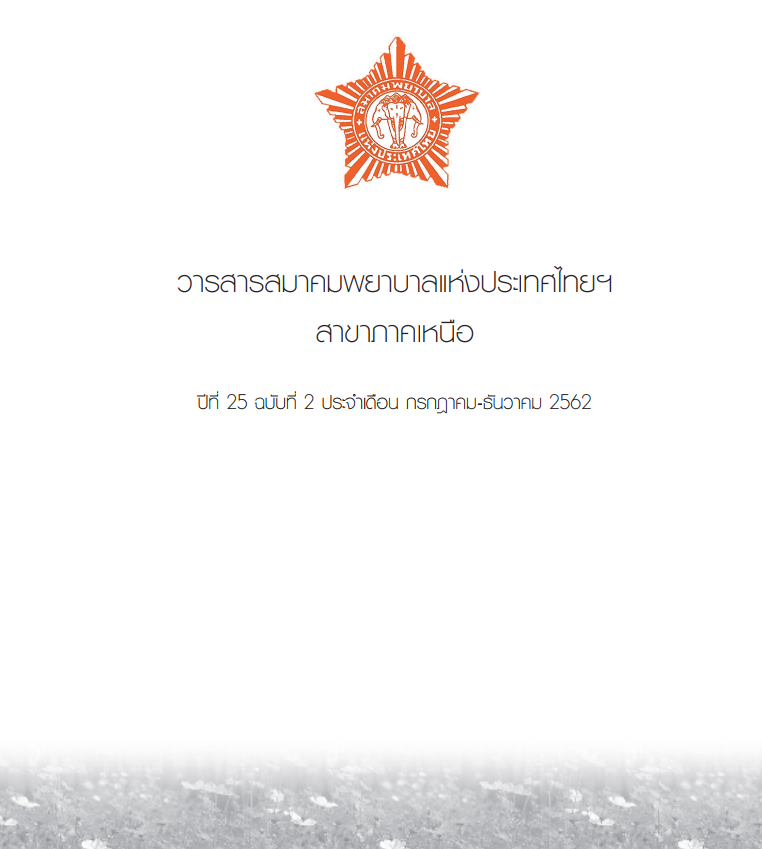Development of an E-learning Program on Maternal–Child Nursing and Midwifery 1 for Nursing Students
Keywords:
Development learning model, E-learning programAbstract
The development of an E-learning Program on Maternal–Child Nursing and Midwifery 1 for Nursing Students aimed to create the teaching model using electronic media for Maternal–Child Nursing and Midwifery 1’s learners. Meanwhile, another objectives were testing and assessment of electronic media teaching model and level of nursing students’ satisfaction that taught by using electronic media. The group of samples were divided into 2 phases by the period of study. Including phase 1 and phase 2 which are the process of studying the behavior of using the electronics media of Boromarajonani College of Nursing students, Chiang Mai, the sample group consisted of 10 students who study in the course of Maternal–Child Nursing and Midwifery 1, in the first semester of academic year 2015. And the process of testing of Maternal–Child Nursing and Midwifery 1 students that using. electronic study material and evaluation of electronic media which using 68 of Maternal–Child Nursing and Midwifery 1 students in the third semester academic year 2015 respectively. The research instruments consisted of 1) Electronic media on the physiology of newborns and newborn health assessment. 2) The testing material that aimed to examined the of knowledge of physiology of newborns and newborn health assessment which contains 20 items as choices. 3) The assessment for satisfaction of students whom study physiology of newborns and newborn health assessment by using electronic media. The analysis of the data was done by the method of frequency distribution, percentage, mean, standard deviation and Independent sample t-test The result presented that 66.2 % of students use the internet 6-7 days/week, as 38.2 % of the student have a fair level in learning by electronic media and 63.2% of students know from the lectures.
The result was developed of an electronic learning tool for “physiology of newborns and newborn health assessment”. at the second phase contained the process of the assessment for the study in the course of Maternal–Child Nursing and Midwifery 1. The sample groups were the students who the been taught the electronic media in accordance with the normal model of teaching and the students who received only the normal model of teaching which controlled with equivalent characteristic in terms of gender and GPA with the amount of 34 students per group. The result indicated that the average knowledge of nursing student between the 2 sample groups didn’t have a significant difference in a level of 0.05 (=9.32, S.D.=2.43,
=10.02, S.D.=1.81). However, the result demonstrated that average of nursing students who were taught by electronic media was in a high level of satisfaction (
=3.98, S.D.=0.38).
The results of this study can be used as a guideline for the development of electronic media for students who want to review knowledge out of school time. Moreover, there is the additional channel of communication between learners and lecturers. Assessment for satisfaction should be continuously developed to improve the efficiency of media for learning.
References
อภิรดี นันท์ศุภวัฒน์ และเรมวล นันท์ศุภวัฒน์. ความพึงพอใจและผลลัพธ์ของการจัดการเรียนการสอน แบบผสมผสานในกระบวนวิชาภาวะผู้นำและการจัดการทางการพยาบาล ของนักศึกษาพยาบาล คณะพยาบาลศาสตร์มหาวิทยาลัยเชียงใหม่. พยาบาลสาร.2556; 40 (ฉบับพิเศษ): 47-60.
ถนอมพร เลาหจรัสแสง. การสอนบนเว็บ (Web-Based Instruction) นวัตกรรมเพื่อคุณภาพการเรียน การสอน. วารสารศึกษาศาสตร์. 2544; 28(1): 87-94.
เยาวนารถ พันธุ์เพ็ง. การออกแบบการเรียนการสอนด้วยระบบ e-learning = instruction design by e-learning system.วารสารวิชาการศรีปทุมชลบุรี. 2556; 9(4): 21-28.
Clank, R.C. and Mayer, R.E. E-Learning and the science of instruction. New York: John Wiley & Sons, Inc; 2003
Weingarte, M.R. Four Generations, One workplace: A Gen X-Y staff nurse’s view of team bding in emergency department. Journal of emergency Nursing. 2009; 35(1): 27-30
Boychuk, E.J. and Cowin, L. Multigenerational nurse in workplace. Journal of Nursing Administration. 2004; 34(11): 439-501.
เยาวลักษณ์ โพธิดารา. การจัดการศึกษาทางการพยาบาล : สำหรับนักศึกษา Generation Y. วารสาร พยาบาลศาสตร์และสุขภาพ. 2554; 34(2): 61-69.
วรวุฒิ มั่นสุขผล และปุณเชษฐ์ จินางศุกะ. การศึกษาพฤติกรรมและความต้องการใช้อีเลิร์นนิงของ นักศึกษาระดับบัณฑิตศึกษาคณะศึกษาศาสตร์ มหาวิทยาลัยศิลปากร. วารสารวิชาการ Veridian EJournal บัณฑิตวิทยาลัย มหาวิทยาลัยศิลปากร. 2558; 8(3): 347-358. ISSN 1906 – 3431
วณิชา พึ่งชมภู, และศิริรัตน์ ปานอุทัย. การพัฒนารูปแบบการเรียนการสอนด้วย E-Learning สำหรับ นักศึกษาพยาบาลศาสตร์ในกระบวนวิชาการพยาบาลผู้สูงอายุ.พยาบาลสาร. 2557; 41 (ฉบับพิเศษ): 11-25.
สุธิศา ล่ามช้าง และสมจิต เกียรติวัฒนเจริญ. ผลของการเรียนรู้ด้วยตนเองโดยใช้สื่อมัลติมีเดียต่อความรู้และความมั่นใจในการปฏิบัติการพยาบาลเด็กป่วยโรคทางเดินหายใจเฉียบพลันของนักศึกษาพยาบาล. พยาบาลสาร. 2557; 41(2): 107-116.
สวณี เต็งรังสรรค์, สุภิกา แดงกระจ่าง, และเพชรรัตน์ บุนนาค. เปรียบเทียบผลสัมฤทธิ์ทางการเรียน ของนักศึกษาแพทย์มหาวิทยาลัยธรรมศาสตร์ เรื่อง รูปแบบการวิจัยทางวิทยาการระบาดโดยระบบ e-learning กับการบรรยาย. ธรรมศาสตร์เวชสาร. 2557; 14(2): 191-196.
วิทยาลัยพยาบาลบรมราชนนี เชียงใหม่.รายงานผลการดำเนินการของ (มคอ.5) ปีการศึกษา 2557 รายวิชาการพยาบาลมารดาทารกและผดุงครรภ์ 1. 2557.
McGriff, Steven J. Instructional System Design (ISD): Using the ADDIE Model. Instructional Design Models. 2000; 226(14): 1-2.
สุรเชษฐ เวชชพิทักษ์, บุญเลิศ อรุณพิบูลย์, ปรัชญนันท์ นิลสุข และ สมควร เพียรพิทักษ์. การพัฒนา สื่อคอมพิวเตอร์ช่วยสอนและเว็บไซต์เพื่อการเรียนรู้ที่มีคุณภาพ: กรมวิชาการกระทรวงศึกษาธิการ. กรุงเทพฯ: องค์การรับส่งสินค้าและพัสดุภัณฑ์ (ร.ส.พ.); 2546
พิเชษฐ เพียรเจริญ. E-Learning : การใช้และความต้องการของอาจารย์และนักศึกษา มหาวิทยาลัย สงขลานครินทร์วิทยาเขตปัตตานี.วารสารวิทยบริการ. 2549; 17(3): 42-52.
Kiger, M., Hardy, R., & Mitchell, C. Teaching for Health. Edinburgh: Churchill Livingstone; 2004
ไชยยศ เรืองสวุ รรณ. การบริหารระบบงานสื่อและเทคโนโลยีการศึกษา. กรุงเทพฯ: ภาควิชาเทคโนโลยี และสื่อสารการศึกษามหาวิทยาลัยมหาสารคาม; 2534.
อัจฉราวดี ศรียะศักดิ์, วารุณี เกตุอินทร์, สุวรรณี แสงอาทิตย์, และวิโรจน์ ฉิ่งเล็ก. การทดสอบ ประสิทธิภาพของบทเรียนคอมพิวเตอร์บนเครือข่ายอินเทอร์เน็ตเรื่องอุทกเศียรสำหรับนักศึกษา พยาบาลศาสตร์ชั้นปี่ที่ 3. วารสารมหาวิทยาลัยนราธิวาสราชนครินทร์. 2554; 3(1): 91-103.
สุจิตรา ชัยวุฒิ, สุกัญญา ปริสัญญกุล, ฉวี เบาทรวง และกิ่งฟ้า แสงลี. การพัฒนาโปรแกรมคอมพิวเตอร์ ช่วยสอน เรื่อง การประเมินความก้าวหน้าในระยะคลอด. พยาบาลสาร. 2554; 38(3): 10-19.
Downloads
Published
How to Cite
Issue
Section
License
บทความที่ได้รับการตีพิมพ์เป็นลิขสิทธิ์ของสมาคมพยาบาลแห่งประเทศไทยฯ สาขาภาคเหนือ
เนื้อหาและข้อคิดเห็นใดๆ ที่ตีพิมพ์ในวารสารสมาคมพยาบาลฯ ถือเป็นความรับผิดชอบของผู้เขียนเท่านั้น ผู้เขียนบทความต้องศึกษารายละเอียดหลักเกณฑ์การจัดทำต้นฉบับตามที่วารสารกำหนด และเนื้อหาส่วนภาษาอังกฤษต้องได้รับการตรวจสอบจากเจ้าของภาษามาแล้ว


